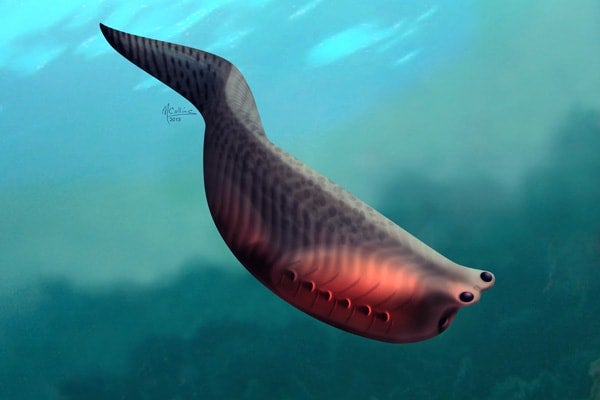
New fossil find shows how jaws evolved in tiny, ancient fish ancestor
Published: June 12, 2014
Jean-Bernard Caron of the Departments of Earth Sciences and Ecology & Evolutionary Biology at the University of Toronto, has uncovered a remarkable piece in the puzzle of the evolution of vertebrates.
The fossilised fish, known as Metaspriggina, dates back to the Cambrian period (about 505 million years ago). It shows pairs of exceptionally well-preserved arches near the front of its body. The first of these pairs, closest to the head, eventually led to the evolution of jaws in vertebrates, the first time this feature has been seen so early in the fossil record.
“Fish fossils from the Cambrian period are very rare and usually poorly preserved," said Caron, leader of the 2012 expeditions that recovered the specimens.
“This new discovery shows in unprecedented detail how some of the earliest vertebrates developed – the starting point of a story which led to animals such as later fish species, but also dinosaurs and mammals such as horses and even humans,” said Caron, who is also curator of invertebrate palaeontology at the Royal Ontario Museum.
The findings are published in the June 11 edition of the journal Nature.
 Fossils of Metaspriggina were recovered from several locations by Caron (pictured at left) and his team including the Burgess Shale site in Canada’s Rocky Mountains, one of the richest Cambrian fossil deposits in the world. These fossils shed new light on the Cambrian ‘explosion’, a period of rapid evolution starting around 540 million years ago, when most major animal phyla originated. (photo by Jean-Bernard Caron © ROM)
Fossils of Metaspriggina were recovered from several locations by Caron (pictured at left) and his team including the Burgess Shale site in Canada’s Rocky Mountains, one of the richest Cambrian fossil deposits in the world. These fossils shed new light on the Cambrian ‘explosion’, a period of rapid evolution starting around 540 million years ago, when most major animal phyla originated. (photo by Jean-Bernard Caron © ROM)
Previously, only two incomplete specimens of Metaspriggina had been identified. In 2012, Caron’s group collected 44 new Burgess Shale fossils near Marble Canyon in Kootenay National Park in British Columbia. Caron along with palaeontologist Simon Conway Morris of the University of Cambridge’s Department of Earth Sciences used these fossils, as well as several more specimens from the eastern United States, to reclassify Metaspriggina as one of the first vertebrates.
The fossils also show how a series of rod-like structures, known as the gill or branchial arches, were arranged in the earliest vertebrates. These arches have long been known to have played a key role in the evolution of vertebrates, including the origin of jaws, and some of the tiny bones in the ear which transmit sound in mammals. Until now, however, a lack of quality fossils has meant that the arrangement of these arches in the first vertebrates had been hypothetical.
“Vertebrates first appear in the fossil record slightly earlier than these finds, but pinpointing exactly how they developed is difficult,” said Caron. “This is because fossils of such animals are rare, incomplete and open to varying interpretations, as they show soft tissues which are difficult to identify with complete certainty.”
The new fossils of Metaspriggina are remarkably well-preserved. The arrangement of the muscles shows these fish were active swimmers, not unlike a trout, and the animals saw the world through a pair of large eyes and sensed their surrounding environment with nasal structures.
“The detail in this Metaspriggina fossil is stunning,” said Conway Morris, lead author of the Nature study. “Even the eyes are beautifully preserved and clearly evident.”
But it is the branchial arches which makes this discovery so important. Previously, they were thought to exist as a series of single arches, but Metaspriggina now shows that they in fact existed in pairs. The anterior-most pair of arches is also slightly thicker than the remainder, and this subtle distinction may be the very first step in an evolutionary transformation that in due course led to the appearance of the jaw.
“Once the jaws have developed, the whole world opens,” said Conway Morris. “Having a hypothetical model swim into the fossil record like this is incredibly gratifying.”
“Obviously jawed fish came later, but this is like a starting post – everything is there and ready to go,” said Caron. “This is a major discovery that will play a key role in understanding our own origins.
"We also believe that Marble Canyon, the new Burgess Shale locality where many of the fossils were found, has fantastic potential for revealing key insights into the early evolution of many other animal groups during this crucial time in the history of life.”
Sean Bettam is a writer with the Faculty of Arts & Science at the University of Toronto.



